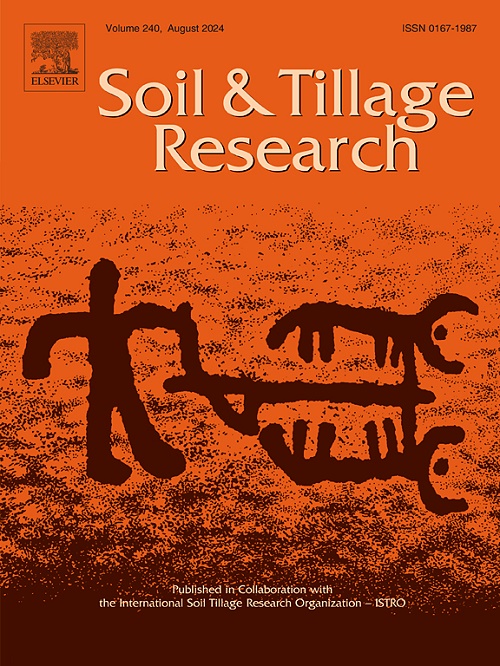Chitin-enriched compost to increase soil moisture retention and resilience against drought
IF 6.1
1区 农林科学
Q1 SOIL SCIENCE
引用次数: 0
Abstract
Intensified droughts under future climate are threatening agricultural production in Western Europe. As a consequence, there is a growing interest in soil amendments that have the capability to enhance the water storage capacity of soils, increasing their resilience against drought. Chitin is a natural biopolymer known to hold potential to improve soil moisture retention. Considering the variable success of compost on soil hydrological properties documented in literature, enriching compost with a soil amendment such as chitin could potentially improve the functioning of the compost. An eight-week pot experiment with lettuce as test crop was set up under greenhouse conditions where multiple treatments consisting of a sandy loam soil mixed with 1 g kg−1 or 2 g kg−1 of crude chitin in its pure form, mixed with compost as chitin-enriched compost, and three types of pure compost were tested under two water regimes. The addition of crude chitin without compost, after this referred to as pure chitin significantly increased the readily available water defined as the macro-mesoporosity (30 µm – 3 µm) and the plant available water after this referred to as the mesoporosity (30 µm – 0.2 µm) under water regime 1, which comprised a sudden, dry period halfway the growing period of the crop. Under this water regime, the treatment with chitin-enriched compost resulted in a significant improvement in macro-mesoporosity and mesoporosity, when compared to the unamended compost. A different trend was obtained under the second water regime, featuring a cyclic pattern of dry periods, which points to the importance of the environmental conditions with regard to the functioning of chitin. These results highlight the potential of chitin-based amendments to enhance soil water retention properties, with their effectiveness strongly influenced by the prevailing water regime.
富含几丁质的堆肥可提高土壤的保水能力和抗旱能力
未来气候加剧的干旱正威胁着西欧的农业生产。因此,人们对土壤改良剂越来越感兴趣,因为它有能力增强土壤的蓄水能力,增强其抗旱能力。几丁质是一种天然的生物聚合物,已知具有改善土壤水分保持的潜力。考虑到文献中记录的堆肥对土壤水文特性的不同成功,用几丁质等土壤改良剂丰富堆肥可能会改善堆肥的功能。以生菜为试验作物,在温室条件下进行了为期8周的盆栽试验,其中多种处理包括砂壤土混合1 g kg−1或2 g kg−1的纯几丁质,与堆肥混合为富含几丁质的堆肥,并在两种水制度下测试了三种类型的纯堆肥。添加未经堆肥的粗几丁质,在此之后称为纯几丁质,显著增加了大介孔率(30 µm - 3 µm)和植物有效水分(30 µm - 0.2 µm),在水制度1下,这包括作物生长期中途的突然干燥期。在这种水分条件下,与未加改性的堆肥相比,富含几丁质的堆肥处理显著改善了宏观介孔率和介孔率。在第二种水状态下获得了不同的趋势,具有干旱期的循环模式,这指出了环境条件对甲壳素功能的重要性。这些结果突出了几丁质基改改剂增强土壤保水特性的潜力,其有效性受到现行水制度的强烈影响。
本文章由计算机程序翻译,如有差异,请以英文原文为准。
求助全文
约1分钟内获得全文
求助全文
来源期刊

Soil & Tillage Research
农林科学-土壤科学
CiteScore
13.00
自引率
6.20%
发文量
266
审稿时长
5 months
期刊介绍:
Soil & Tillage Research examines the physical, chemical and biological changes in the soil caused by tillage and field traffic. Manuscripts will be considered on aspects of soil science, physics, technology, mechanization and applied engineering for a sustainable balance among productivity, environmental quality and profitability. The following are examples of suitable topics within the scope of the journal of Soil and Tillage Research:
The agricultural and biosystems engineering associated with tillage (including no-tillage, reduced-tillage and direct drilling), irrigation and drainage, crops and crop rotations, fertilization, rehabilitation of mine spoils and processes used to modify soils. Soil change effects on establishment and yield of crops, growth of plants and roots, structure and erosion of soil, cycling of carbon and nutrients, greenhouse gas emissions, leaching, runoff and other processes that affect environmental quality. Characterization or modeling of tillage and field traffic responses, soil, climate, or topographic effects, soil deformation processes, tillage tools, traction devices, energy requirements, economics, surface and subsurface water quality effects, tillage effects on weed, pest and disease control, and their interactions.
 求助内容:
求助内容: 应助结果提醒方式:
应助结果提醒方式:


